Table of contents
Introduction
The theory of anomie offers a profound understanding of the breakdown of social norms and its consequences on individual behavior, particularly in the context of crime and deviance. Originating from the works of Emile Durkheim and later expanded by Robert K. Merton, anomie describes a state of normlessness, where the lack of clear social expectations leads to deviant behavior. This theory is especially significant in explaining juvenile delinquency, where the disintegration of societal structures and values contributes to the rise in unlawful activities among young individuals.
Juveniles, being more susceptible to societal pressures and rapid changes in social conditions, are often influenced by the breakdown of traditional norms and values, leading them towards delinquency. The theory of anomie highlights the disparities between societal goals and the means available to achieve them, which often results in frustration, particularly among marginalized youth. Understanding anomie in the context of juvenile delinquency is crucial for identifying the root causes of deviant behavior among adolescents and developing targeted interventions within the criminal justice system.
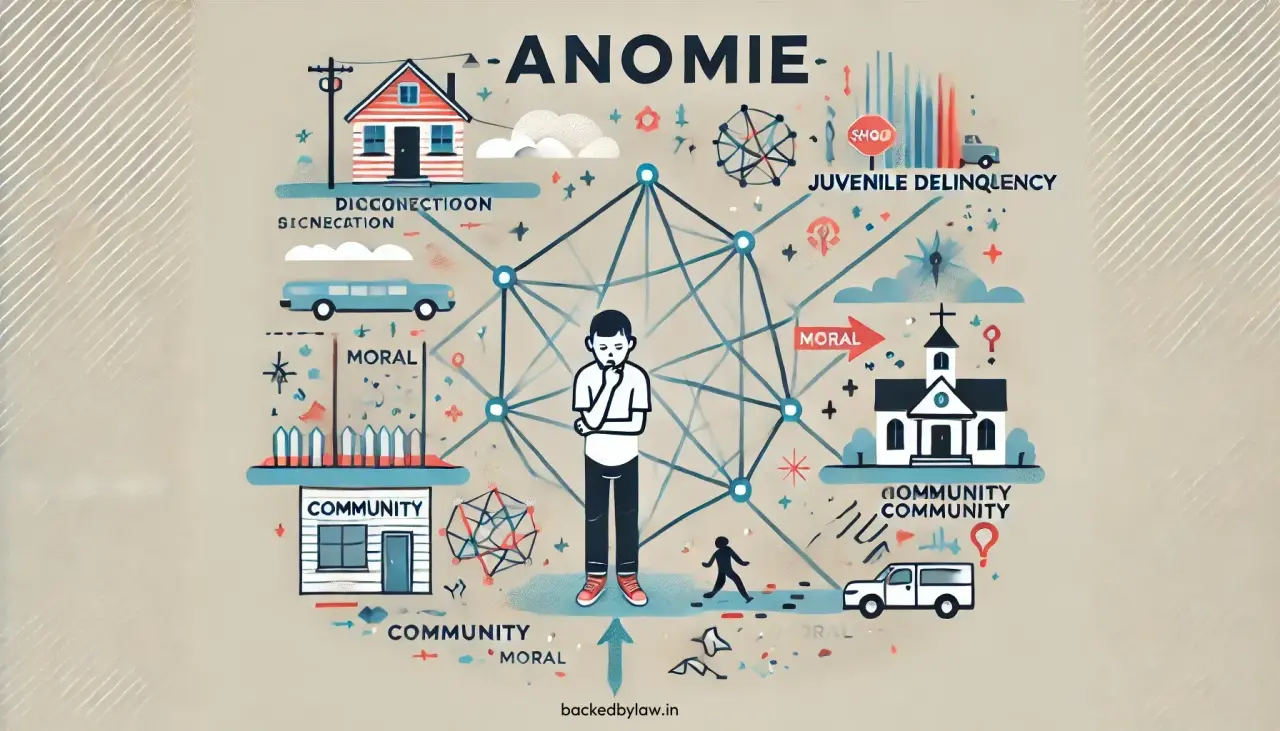
Understanding the anomie theory
-
Concept of Social Normlessness (Anomie)
The word comes from Greek which means “without law”. In simple English it can be understood as “normlessness”. The term “anomie” was used by Emile Durkheim a French sociologists as a “reaction against the regulatory social controls of the society. In the 19th century Durkheim took this word from the book “Suicide” written by the French philosopher Guyau that described it as a feeling of alienation and purposelessness. According to Durkheim, the normlessness, i.e., lack of regulation result in deviant behaviour. Therefore, anomie can be said to be a condition in which there is a breakdown of social regulation and thus having such behaviours that are unacceptable by the society.
The concept of anomie refers to a state of normlessness, where social norms and values that guide behavior are weakened or absent. In such a situation, individuals experience confusion or instability regarding their place in society and the acceptable means to achieve success. The term was first introduced by Emile Durkheim, a French sociologist, who used it to describe the social disintegration that occurs when society fails to provide clear guidelines for its members.
In an anomic state, individuals are unable to align their aspirations with societal norms, leading to feelings of frustration, isolation, and sometimes rebellion. This lack of social regulation creates a fertile ground for deviance and criminal behavior, as the traditional structures that govern acceptable behavior lose their influence.
For juveniles, this state of normlessness is particularly significant because adolescents are in the process of developing their moral and social understanding. Without clear guidance from societal institutions such as the family, school, and community, juveniles are more likely to resort to deviant behavior as a means of coping with their confusion or dissatisfaction. The disconnect between socially approved goals (such as success and status) and the legitimate ways of achieving them often pushes juveniles towards criminal activities as a response to their perceived inequality or alienation.
Anomie thus highlights how the breakdown of social norms can lead individuals, particularly juveniles, to engage in delinquent behavior as they navigate a world without clear moral or social boundaries.
-
Emile Durkheim’s contribution
Emile Durkheim, a founding figure in sociology, introduced the concept of anomie to describe a condition where social norms break down, leading to a state of normlessness. In his seminal work, "The Division of Labor in Society" (1893) and later in "Suicide" (1897), Durkheim used anomie to explain the social causes of deviance and abnormal behavior, including juvenile delinquency.
Durkheim argued that anomie occurs during periods of rapid social change or when the structures that define and regulate individual behaviors, such as laws, traditions, and norms, lose their authority. During such times, individuals struggle to adapt to the new conditions, leading to feelings of isolation, frustration, and deviance.
He believed that social cohesion is maintained when individuals are bound by a common set of norms and values, but when society experiences disruption—whether through economic crises, technological advancements, or social upheavals—those norms are weakened, leaving individuals without clear guidelines. For juveniles, such a breakdown can be particularly damaging, as they rely heavily on societal structures for their development and sense of belonging.
Durkheim's concept of anomie explains how the disintegration of societal norms can lead to higher rates of crime and deviant behavior, particularly among vulnerable groups like adolescents. Juvenile delinquency, according to Durkheim, is often a direct result of the absence of effective social regulation during critical stages of youth development.
-
Robert K. Merton’s Strain theory and its extension
Building on Durkheim's concept of anomie, Robert K. Merton, an American sociologist, expanded the theory through his famous Strain Theory, which is key to understanding juvenile delinquency. In his work "Social Structure and Anomie" (1938), Merton argued that societal structures exert pressure on individuals to achieve socially approved goals, such as wealth and success, but not everyone has equal access to the legitimate means of achieving them.
Merton's theory suggests that when there is a discrepancy between cultural goals (e.g., financial success) and the institutionalized means to achieve them (e.g., education, employment), individuals experience strain. This strain can lead to different forms of adaptation, some of which result in deviant behavior. He identified five modes of individual adaptation:
- Conformity – Adherence to societal goals and means.
- Innovation – Acceptance of societal goals but using illegitimate means to achieve them (common in juvenile offenders).
- Ritualism – Rejection of societal goals but strict adherence to legitimate means.
- Retreatism – Rejection of both societal goals and means (e.g., drug addicts, dropouts).
- Rebellion – Rejection and replacement of societal goals and means.
Merton’s extension of Durkheim’s anomie theory into strain theory is critical in understanding why certain social groups, particularly underprivileged youth, are more prone to delinquent behavior. Juveniles, facing societal pressure to succeed but lacking the resources to do so through legitimate means, are often driven towards criminal activities as a coping mechanism for the strain they experience. Merton's theory highlights the importance of addressing systemic inequalities to prevent the alienation and deviance of marginalized youth.
-
Relevance to Juvenile Behaviour
The theory of anomie and its extension through Merton’s Strain Theory provide a crucial framework for understanding juvenile behavior, particularly in the context of delinquency. Juveniles are in a developmental phase where they are heavily influenced by societal norms, values, and the expectations placed upon them by family, peers, and institutions. When these social structures fail to provide clear guidance or adequate opportunities, many juveniles may experience anomie—a state of normlessness or confusion—leading to deviant behavior as a means of coping with their sense of alienation and frustration.
-
Social Disintegration and Confusion
Anomie is particularly relevant to juvenile behavior because adolescents are more susceptible to societal disruptions and normlessness. As they seek their identity and place in society, they rely on family, education, and community to guide their moral compass. However, when these institutions fail—due to poverty, family breakdown, or inadequate educational opportunities—juveniles often struggle to find legitimate ways to achieve success. This confusion leads to deviant or delinquent behavior, as juveniles may seek alternative, often illegal, ways to gain status or financial security.
-
Strain and Societal Pressure
According to Merton’s Strain Theory, juveniles are often caught in the tension between society’s prescribed goals (such as material success or social status) and the limited means available to them to achieve those goals legitimately. Juveniles from underprivileged backgrounds, in particular, may find that they cannot meet societal expectations through education or employment. As a result, many may resort to illegitimate means—such as theft, drug trafficking, or gang involvement—to achieve success, thus falling into delinquency.
For instance, a juvenile growing up in an impoverished neighborhood, with few educational or employment opportunities, might feel intense pressure to achieve the same level of material success as wealthier peers. However, with limited legal avenues to do so, they may turn to criminal activities as a way to meet those societal expectations.
-
Peer Influence and Deviance
Anomie and strain are also reflected in peer group dynamics among juveniles. Adolescents often turn to peers for support and validation, particularly when they feel isolated or disconnected from societal institutions like family or school. In environments where deviant behavior is normalized within peer groups (such as in gangs), juveniles may adopt such behavior to fit in or gain recognition. The absence of clear social norms, combined with peer pressure, can lead to higher rates of delinquency, as juveniles seek to resolve their anomic state through deviance.
-
Increased Vulnerability to Delinquency
Juveniles, who are still in the process of moral and social development, are particularly vulnerable to the effects of anomie. Their incomplete cognitive development makes them less equipped to deal with the frustration and strain caused by societal inequalities or broken institutions. This vulnerability explains why juvenile delinquency often spikes in communities where social structures are weak, and why rehabilitation and social reform are critical in addressing youth crime.
In essence, anomie theory, along with Merton’s extension, highlights the significant role that social structures play in either fostering conformity or pushing juveniles towards deviant behavior. By understanding the relevance of these theories to juvenile delinquency, society can better develop strategies for prevention, rehabilitation, and social support for at-risk youth.
-
Social Disintegration and Confusion
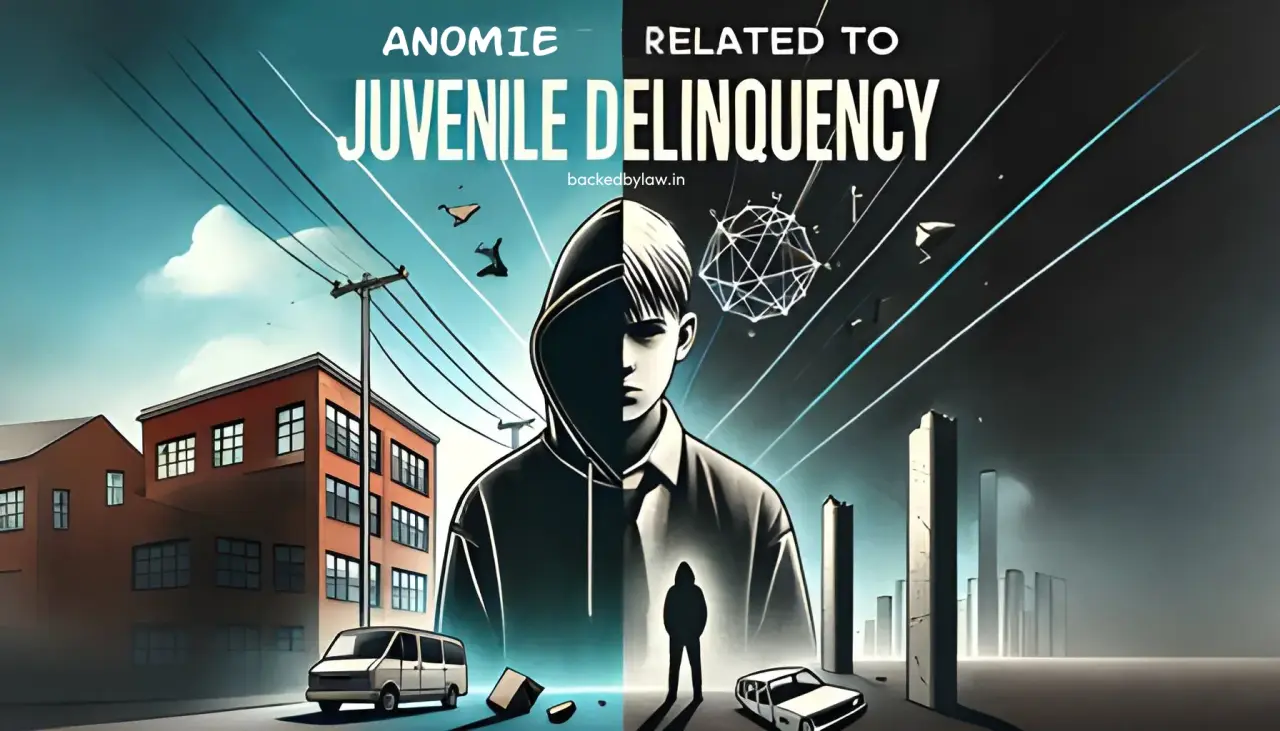
Anomie and Juvenile Delinquency
-
Connection between social structure and Juvenile crime
The connection between social structure and juvenile crime is foundational in understanding the theory of anomie. Social structures encompass the institutions, norms, and relationships that shape individual behavior and social expectations. When these structures are robust and functioning effectively, they provide individuals, particularly juveniles, with clear guidelines and pathways to achieve success.
However, when social structures become weakened or disintegrate—due to economic disparities, family breakdowns, or community disorganization—juveniles often find themselves in environments where the norms governing behavior are unclear or absent. This lack of social cohesion and support creates a situation where young people may perceive limited legitimate opportunities for success, leading them to engage in criminal activities as alternative means of achieving societal goals.
For example, research shows that adolescents living in economically disadvantaged neighborhoods, where community resources and social networks are lacking, are more likely to engage in delinquent behavior. The inability to access legitimate avenues for achievement often results in juveniles resorting to crime as a means to gain respect, status, or financial rewards.
-
Impact of social disintegration on adolescents
Social disintegration profoundly affects adolescents, who are particularly vulnerable to the psychological and emotional consequences of unstable environments. When familial, educational, and community structures break down, adolescents may experience feelings of isolation, confusion, and neglect. This disintegration can manifest in various ways, including increased rates of mental health issues, low self-esteem, and a lack of direction.
Adolescents may find it challenging to develop healthy relationships and trust, leading to an increased likelihood of engaging with negative peer groups. In these contexts, without supportive structures, they may seek affirmation and belonging from peers engaged in delinquent behavior, further entrenching them in a cycle of crime. The lack of positive role models and mentors exacerbates the problem, as juveniles are left without guidance on acceptable behavior or coping strategies.
-
Breakdown of norms and increase in Juvenile offending
The breakdown of societal norms directly correlates with an increase in juvenile offending. Norms function as behavioral guidelines that dictate what is acceptable in society. When these norms are unclear or eroded, juveniles may feel unbound by societal expectations, resulting in a higher likelihood of engaging in criminal activities.
For instance, during periods of social upheaval or economic downturns, societal values may shift, leading to an increase in competitive behavior and the normalization of deviance. In such environments, juveniles may observe or experience criminal behavior as an accepted or even necessary means of survival. This erosion of norms creates an environment where delinquency is not only possible but, in some cases, viewed as a rational response to their circumstances.
Studies have shown that in communities marked by high levels of violence, poverty, and social isolation, juvenile crime rates tend to rise. The absence of consistent social norms results in an environment where illegal activities are perceived as viable options for achieving success, further perpetuating the cycle of delinquency.
-
Examples of deviant behaviour in juveniles due to anomie
Several forms of deviant behavior among juveniles can be attributed to the state of anomie, illustrating the practical implications of the theory:
- Theft and Burglary: In economically deprived neighborhoods, juveniles may resort to theft to acquire material goods or fulfill perceived societal expectations of success. The normalization of theft within their peer groups can further encourage this behavior.
- Drug Abuse and Trafficking: Anomie can lead to increased drug use and trafficking among adolescents seeking escape from their reality or attempting to gain financial rewards. In environments lacking positive outlets or support, the illicit drug trade may appear as an attractive option for achieving success or fitting in with peers.
- Gang Involvement: The absence of social cohesion often pushes juveniles toward gang affiliation, where they find a sense of belonging and identity. Gangs frequently provide an alternative structure that may reinforce criminal behavior, as youths engage in illegal activities to gain status and recognition within the group.
- Violent Crime: In areas where norms governing non-violence are weakened, juveniles may resort to violent behavior as a means of resolving conflicts or asserting dominance. The prevalence of violence in their surroundings can further desensitize them to its consequences.
- Theft and Burglary: In economically deprived neighborhoods, juveniles may resort to theft to acquire material goods or fulfill perceived societal expectations of success. The normalization of theft within their peer groups can further encourage this behavior.
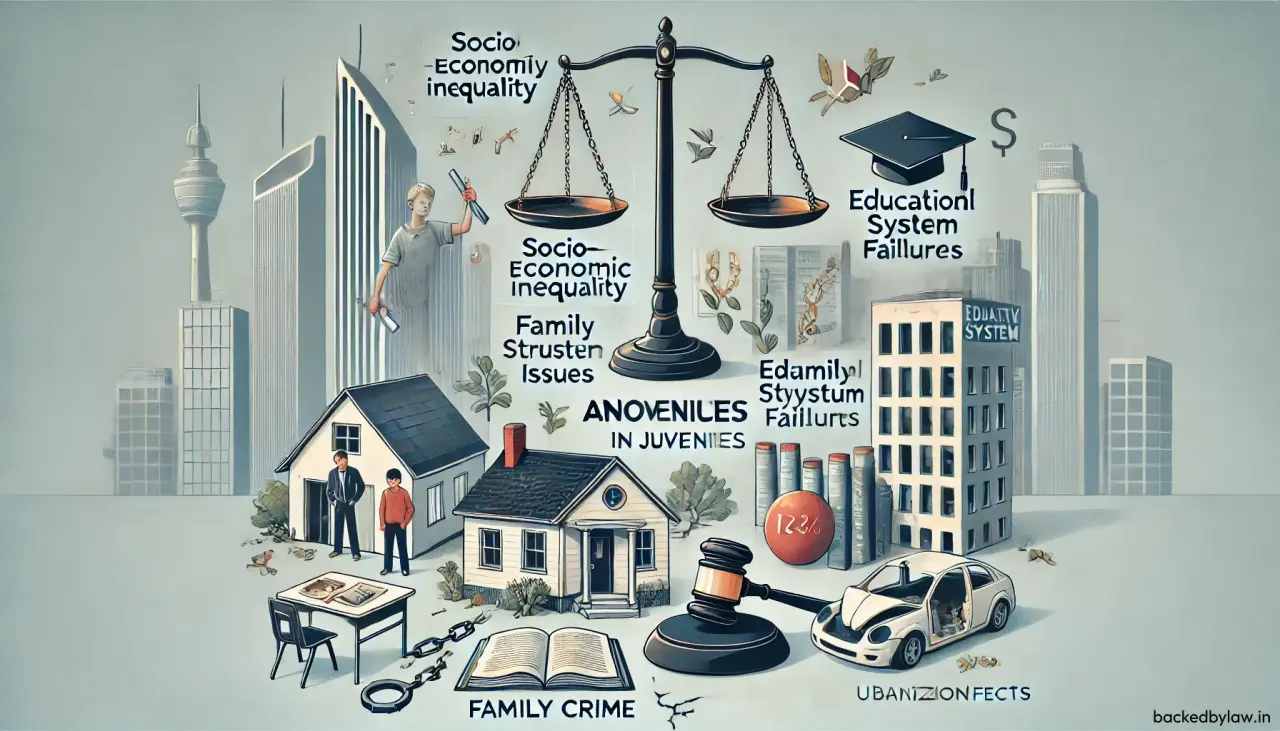
Factors Contributing to Anomie in Juveniles
-
Socio-Economic Inequality and Juvenile Crime
Socio-economic inequality is a significant factor contributing to anomie among juveniles. When there is a stark contrast between the wealthy and the impoverished, it creates an environment where opportunities for legitimate success become scarce for lower socio-economic groups. This inequality can lead to feelings of frustration and alienation among adolescents, who may perceive that societal goals—such as financial stability and social status—are unattainable through conventional means.
Juveniles in impoverished areas may witness their wealthier peers achieving success, often through education or stable employment, while they struggle with limited resources and opportunities. This gap can drive them toward deviant behavior as a means to close the perceived divide, leading to increased rates of theft, drug dealing, or other criminal activities. Research has consistently shown that areas with high levels of economic disparity experience higher rates of juvenile crime, highlighting the role of socio-economic factors in fostering anomie.
-
Family Structure and Dysfunctional Homes
The structure and dynamics of the family play a crucial role in shaping a juvenile's behavior and sense of belonging. Dysfunctional families, characterized by poor communication, neglect, abuse, or inconsistent parenting, can significantly contribute to anomie among adolescents. In such environments, children may lack the guidance and support necessary to navigate societal expectations, leading to confusion about norms and acceptable behaviors.
When family structures break down—whether due to divorce, single-parent households, or domestic violence—juveniles may feel isolated and unsupported. This absence of a nurturing environment can result in low self-esteem and a lack of direction, pushing them toward negative peer groups for validation. Studies have shown that juveniles from dysfunctional families are more likely to engage in delinquent behavior, as they often seek to fulfill their emotional and social needs through deviant means.
-
Educational System Failures
The educational system is a critical institution that helps instill social norms and values in youth. However, when the education system fails to provide adequate support and resources, it can contribute to anomie among juveniles. Factors such as overcrowded classrooms, lack of qualified teachers, and insufficient funding can lead to poor academic performance and disengagement from school.
When students feel disconnected from their educational environment, they may perceive school as irrelevant or unhelpful in achieving their goals. This disconnection can lead to increased dropout rates and a lack of legitimate pathways to success, fostering a sense of hopelessness. In turn, these feelings may push juveniles to seek alternative means of success, often through criminal activities. Research indicates that schools in disadvantaged areas with high dropout rates correlate with increased juvenile delinquency, underscoring the importance of a robust educational system in mitigating anomie.
-
Urbanization and Its Effects on Juvenile Behavior
Urbanization has dramatically transformed social landscapes, often contributing to anomie among juveniles. The rapid growth of urban areas can lead to social disorganization, where traditional community bonds weaken, and individuals become more isolated. In densely populated urban environments, juveniles may experience heightened competition for resources, exacerbating feelings of alienation and frustration.
Urban settings often feature a mix of socio-economic conditions, leading to disparities that can create tension and conflict. The anonymity of urban life can also contribute to a breakdown of social norms, as individuals may feel less accountable for their actions. For juveniles, the lack of cohesive community support and increased exposure to crime can normalize deviant behavior, making it more likely that they will engage in criminal activities.
Furthermore, urbanization often leads to increased gang activity, as adolescents seek belonging and identity within these groups in the absence of strong community ties. Gangs may offer a sense of security and support, albeit through criminal means, further entrenching the cycle of delinquency.
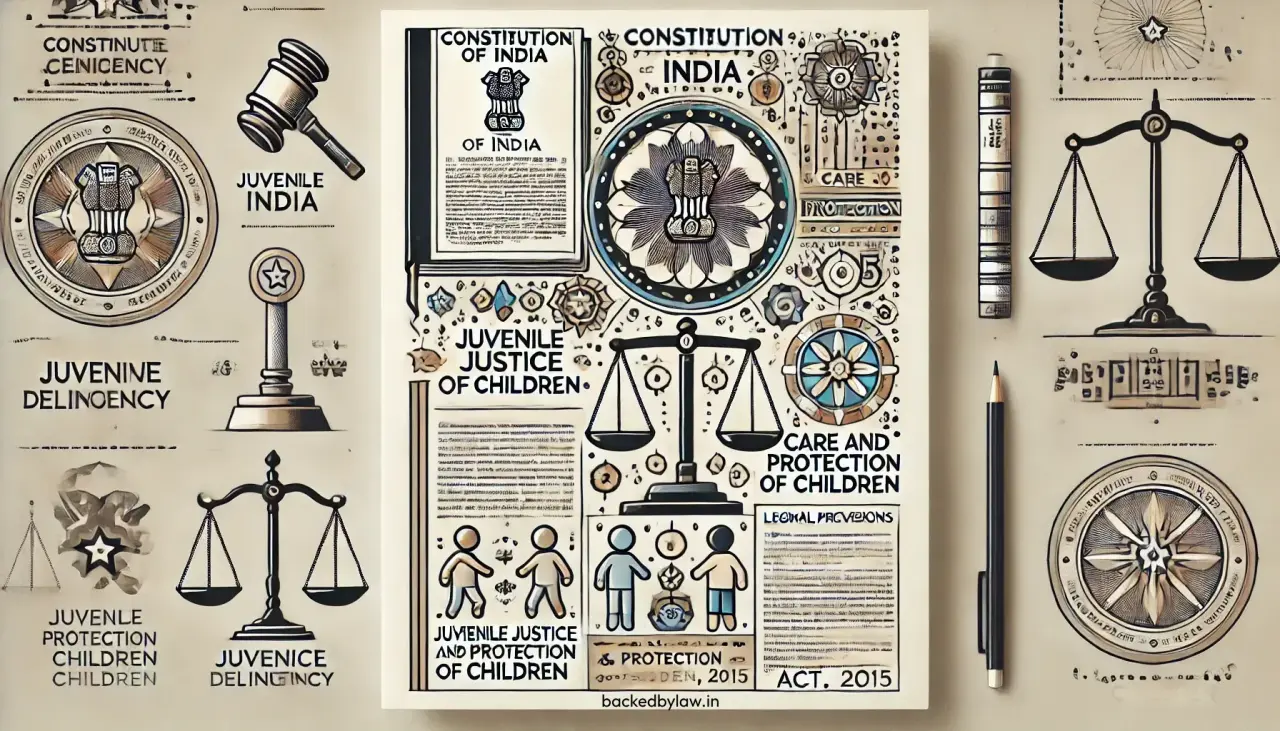
Legal Framework Addressing Juvenile Delinquency in India
-
Constitutional Provisions
The Indian Constitution, adopted in 1950, lays down several provisions that specifically protect the rights of children and address issues related to juvenile justice. Key articles relevant to children include:
- Article 15( 3 ): This article empowers the state to make special provisions for children. It recognizes that children require additional protection and support, enabling the government to enact laws aimed at safeguarding their rights and welfare.
- Article 21A: This article guarantees the right to free and compulsory education for children aged 6 to 14 years. Recognizing education as a fundamental right, this provision emphasizes the importance of ensuring that all children, including those from marginalized communities, receive an education, which is crucial for their development and integration into society.
- Article 23: This article prohibits trafficking in human beings and forced labor. It protects children from exploitation in labor markets, addressing the socio-economic conditions that can lead to juvenile delinquency.
- Article 24: This article forbids the employment of children below the age of 14 years in hazardous industries and establishments. It reflects a commitment to safeguarding children's health and well-being, ensuring that they are not subjected to harmful working conditions.
- Article 39(e): This article directs the state to ensure that children are not exploited and that childhood and youth are protected against neglect and against conditions that are detrimental to their development.
- Article 39(f): This provision mandates that the state must ensure that children are not forced to work and that their education and development are prioritized.
- Article 45: This article requires the state to provide early childhood care and education for all children until they complete the age of six years, emphasizing the importance of early development.
- Article 47: This article directs the state to raise the level of nutrition and standard of living of its people, particularly vulnerable groups, including children, to ensure their overall well-being.
- Article 51(k): This article encourages the state to promote harmony and the spirit of common brotherhood amongst all people, transcending religious, linguistic, and regional or sectional diversities, which is crucial for a harmonious social environment where children can thrive.
- Article 15( 3 ): This article empowers the state to make special provisions for children. It recognizes that children require additional protection and support, enabling the government to enact laws aimed at safeguarding their rights and welfare.
-
Juvenile Justice (Care and Protection of Children) Act, 2015
The Juvenile Justice (Care and Protection of Children) Act, 2015 is a significant legislative framework in India aimed at addressing juvenile delinquency and ensuring the welfare of children in need of care and protection. Key features of this act include:
- Definition of a Child: The Act defines a child as any person who has not completed the age of 18 years, ensuring that all juveniles are provided with special consideration under the law.
- Two-Tier System: The Act establishes a two-tier system for dealing with juveniles in conflict with the law: the Juvenile Justice Board (JJB) for those who commit offenses and the Child Welfare Committee (CWC) for children in need of care and protection. This ensures that children are not tried in adult courts and that their cases are handled in a manner suited to their age and psychological development.
- Rehabilitation and Reintegration: The primary objective of the Act is the rehabilitation and social reintegration of juvenile offenders rather than punitive measures. It emphasizes correctional services and provides for the establishment of observation homes, special homes, and aftercare organizations for the rehabilitation of juveniles.
- Protection of Children: The Act also includes provisions for the protection of children from neglect and abuse, providing a comprehensive framework for the care and protection of vulnerable children.
- Serious Offenses: The Act allows for the trial of juveniles aged 16 to 18 years as adults if they commit serious offenses, which reflects a balance between accountability and protection, although it has raised debates about the appropriateness of such measures.
- Definition of a Child: The Act defines a child as any person who has not completed the age of 18 years, ensuring that all juveniles are provided with special consideration under the law.
Judicial Pronouncements Related to Juvenile Delinquency and Anomie
-
Rakesh Kumar v. State of Uttar Pradesh (2010)
In this case, the Supreme Court dealt with the age of the juvenile accused and the relevance of psychological evaluations in determining criminal responsibility. The court ruled that psychological assessments should be considered when adjudicating cases involving juveniles, emphasizing the importance of understanding a juvenile's mental and emotional state. This ruling highlighted how socio-environmental factors, including anomie, could impact a juvenile's behavior and understanding of right and wrong.
-
Suman v. State of Uttar Pradesh (2009)
In this case, the Allahabad High Court examined the role of family and societal support in preventing juvenile delinquency. The court ruled that the absence of a stable family environment could significantly impact a juvenile's behavior and increase the likelihood of engaging in delinquent activities. The judgment emphasized the importance of community support systems in addressing the root causes of delinquency and mitigating the effects of anomie, highlighting the need for rehabilitative measures focused on strengthening familial and social bonds.
-
Karan Singh v. State of Haryana (2018)
In this case, the Supreme Court addressed the issue of juvenile delinquency concerning the age of offenders. The court ruled that if a juvenile is found to be below the age of 18 at the time of the offense, they should be treated under the Juvenile Justice Act, regardless of the offense's severity. This ruling reinforced the idea that age and social circumstances should dictate legal responses to juvenile delinquency, thereby acknowledging the factors contributing to anomie.
-
Anoop R. vs. State of Kerala (2019)
In this case, the Kerala High Court emphasized the importance of the right to a fair trial for juveniles and the need to consider their mental and emotional development. The court acknowledged the impact of social disintegration and anomie on juvenile behavior, asserting that legal processes must account for the psychological and social context of young offenders. This judgment reflects an understanding that many juveniles may engage in delinquency due to societal pressures and the breakdown of norms.
-
Bholi Punja v. State of Madhya Pradesh (1971)
In this case, the Supreme Court highlighted the need for rehabilitation over punishment for juveniles. The court emphasized that juveniles should not be treated as criminals and that their age, background, and circumstances should be considered in legal proceedings. This case reinforced the principle that the juvenile justice system should focus on reform and rehabilitation, acknowledging the role of socio-economic factors in juvenile delinquency.
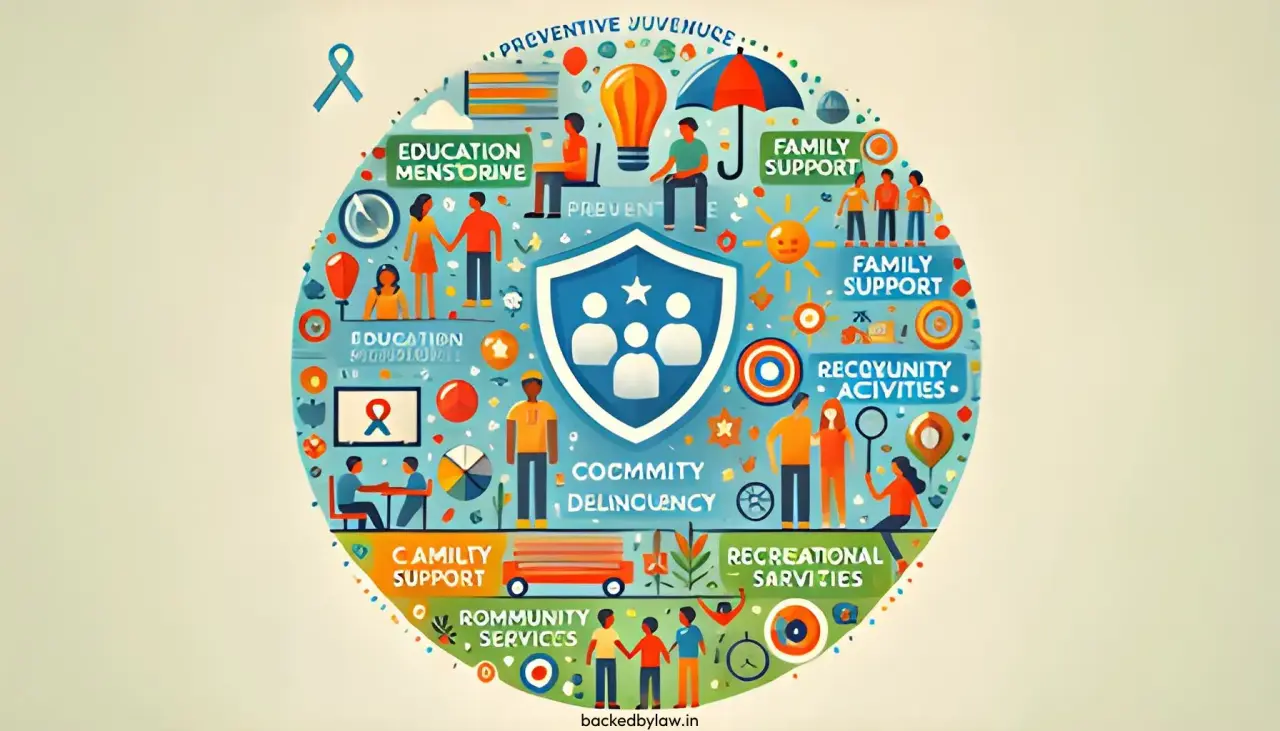
Preventive Measures and Solutions to Address Anomie Among Juveniles
Addressing anomie among juveniles requires a multifaceted approach that targets the underlying social, economic, and environmental factors contributing to delinquent behavior. The following preventive measures and solutions can be implemented to foster a supportive environment for youth, reduce the incidence of juvenile delinquency, and promote their overall well-being.
-
Strengthening Family Support Systems
- Family Counseling Programs: Establish counseling and support services for families facing difficulties, including issues such as domestic violence, substance abuse, and mental health problems. Strengthening family bonds can help create a stable environment for juveniles.
- Parenting Workshops: Conduct workshops to educate parents about effective parenting techniques, communication skills, and the importance of emotional support in child development. These programs can enhance parenting practices and reduce family dysfunction.
- Family Counseling Programs: Establish counseling and support services for families facing difficulties, including issues such as domestic violence, substance abuse, and mental health problems. Strengthening family bonds can help create a stable environment for juveniles.
-
Enhancing Educational Opportunities
- Quality Education: Invest in improving the quality of education in underprivileged areas, including infrastructure, teacher training, and curriculum development. A strong educational foundation can empower juveniles and reduce feelings of alienation.
- After-School Programs: Implement after-school programs that offer tutoring, mentorship, and extracurricular activities. These initiatives can provide juveniles with constructive outlets for their energy and creativity, reducing the likelihood of engaging in delinquent behavior.
- Quality Education: Invest in improving the quality of education in underprivileged areas, including infrastructure, teacher training, and curriculum development. A strong educational foundation can empower juveniles and reduce feelings of alienation.
-
Community Engagement and Development
- Community Centers: Establish community centers that provide safe spaces for juveniles to engage in recreational activities, workshops, and skill development programs. These centers can foster a sense of belonging and community cohesion, countering feelings of isolation and disconnection.
- Youth Leadership Programs: Encourage youth participation in leadership programs and community service initiatives. Involving juveniles in decision-making processes can empower them and give them a sense of agency, reducing the appeal of deviant behavior.
- Community Centers: Establish community centers that provide safe spaces for juveniles to engage in recreational activities, workshops, and skill development programs. These centers can foster a sense of belonging and community cohesion, countering feelings of isolation and disconnection.
-
Addressing Socio-Economic Inequalities
- Employment Opportunities: Create vocational training and employment programs specifically targeted at youth from disadvantaged backgrounds. By equipping juveniles with skills for gainful employment, these initiatives can mitigate the economic pressures that contribute to delinquency.
- Social Welfare Schemes: Enhance social welfare programs aimed at reducing poverty and improving living conditions for marginalized families. Ensuring access to basic needs can alleviate some of the stressors that lead to anomie among juveniles.
- Employment Opportunities: Create vocational training and employment programs specifically targeted at youth from disadvantaged backgrounds. By equipping juveniles with skills for gainful employment, these initiatives can mitigate the economic pressures that contribute to delinquency.
-
Mental Health Support
- Access to Mental Health Services: Increase accessibility to mental health resources for juveniles, including counseling and psychological support. Addressing mental health issues can help juveniles cope with the challenges associated with anomie and reduce the risk of delinquency.
- Awareness Campaigns: Conduct awareness campaigns to destigmatize mental health issues and encourage adolescents to seek help. Promoting mental well-being can prevent the onset of delinquent behavior associated with emotional distress.
- Access to Mental Health Services: Increase accessibility to mental health resources for juveniles, including counseling and psychological support. Addressing mental health issues can help juveniles cope with the challenges associated with anomie and reduce the risk of delinquency.
Conclusion
In conclusion, understanding the theory of anomie is crucial for addressing juvenile delinquency, as it highlights the breakdown of societal norms and the resulting disconnection felt by many young individuals. Effective preventive measures must encompass a holistic approach that targets family support, educational opportunities, community engagement, and socio-economic inequalities. While significant strides have been made in the legal framework and rehabilitative strategies, challenges remain in implementation, societal stigma, and addressing systemic issues contributing to anomie. By fostering collaboration among families, communities, and the justice system, society can create a nurturing environment that empowers juveniles, reduces delinquency, and ultimately promotes a healthier, more cohesive social fabric.